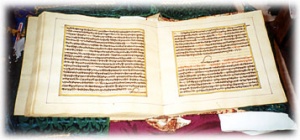Template:Today's featured article: Difference between revisions
Navroopsehmi (talk | contribs) |
Navroopsehmi (talk | contribs) (→[[Japji Sahib Ji]]: - new article of the week) |
||
| Line 1: | Line 1: | ||
==[[ | ==[[Dasam Granth]]== | ||
[[Image: | [[Image:Dasamgranthenh.jpg|thumb|Handwritten script of Sri Dasam Granth Sahib Ji, at Syracuse, New York, U.S.A.|right]] | ||
The Dasam Granth contains 1428 pages and is the collection of the writings of the 10th Patshah, Sri Guru Gobind Singh Ji. It contains his [[Jaap Sahib]], the [[Akal Ustat]] or praise of the Creator, the [[Vachitar Natak]] or Wonderful Drama, in which the Guru gives an account of his parentage, his divine mission, and the battles in which he had been engaged. | |||
Then come three abridged translations of the Devi Mahatamya, an episode in the Markandeya Puran, in praise of Durga the Goddess of war ([[Chandi Chritras]]: Chandi Chritra I, Chandi Chritra II, [[Chandi Ki Var]]). | |||
Then follow the [[Gyan Parbodh]], or awakening of knowledge; [[Chobis Avatar]] - accounts of twenty-four incarnations of the Vishnu, according to the Hindus, and Brahrnavatar and Rudravtdr, selected because of their warlike character; the [[Shabad Hazare]]; quatrains called [[Sawaiyas]], which are religious hymns in praise of God and reprobation of idolatry and hypocrisy; the [[Khalsa Mahima]], or words in praise of the Khalsa; the [[Shastar Nam Mala]], a list of offensive and defensive weapons used in the Guru's time, with special reference to the attributes of the Creator; the [[Tria Charitar]], or tales illustrating the qualities, but principally the deceit of women; the [[Kabiovach Bainti Chaupai]] will "absolve the suffering, pain or fear of the person, who will even once recite this Bani"; the [[Zafarnama]], containing the tenth Guru's epistle to the emporor Aurangzeb; and [[Hikayats]], several metrical tales in the Persian language. | |||
'''[[ | '''[[Dasam Granth|....Continued]]''' | ||
Revision as of 04:20, 11 July 2005
Dasam Granth
The Dasam Granth contains 1428 pages and is the collection of the writings of the 10th Patshah, Sri Guru Gobind Singh Ji. It contains his Jaap Sahib, the Akal Ustat or praise of the Creator, the Vachitar Natak or Wonderful Drama, in which the Guru gives an account of his parentage, his divine mission, and the battles in which he had been engaged.
Then come three abridged translations of the Devi Mahatamya, an episode in the Markandeya Puran, in praise of Durga the Goddess of war (Chandi Chritras: Chandi Chritra I, Chandi Chritra II, Chandi Ki Var).
Then follow the Gyan Parbodh, or awakening of knowledge; Chobis Avatar - accounts of twenty-four incarnations of the Vishnu, according to the Hindus, and Brahrnavatar and Rudravtdr, selected because of their warlike character; the Shabad Hazare; quatrains called Sawaiyas, which are religious hymns in praise of God and reprobation of idolatry and hypocrisy; the Khalsa Mahima, or words in praise of the Khalsa; the Shastar Nam Mala, a list of offensive and defensive weapons used in the Guru's time, with special reference to the attributes of the Creator; the Tria Charitar, or tales illustrating the qualities, but principally the deceit of women; the Kabiovach Bainti Chaupai will "absolve the suffering, pain or fear of the person, who will even once recite this Bani"; the Zafarnama, containing the tenth Guru's epistle to the emporor Aurangzeb; and Hikayats, several metrical tales in the Persian language.

